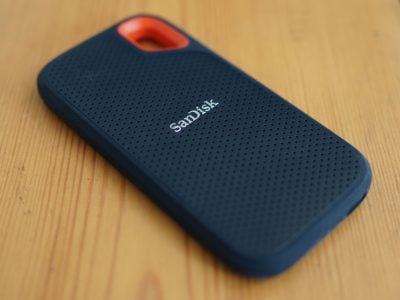SanDisk Extreme Portable SSD review
-
-
Written by Gordon Laing
The SanDisk Extreme Portable SSD is a rugged, pocket-sized drive that connects to new and old USB ports and exploits the size, speed and robustness of solid state storage. It works with Macs and PCs and is available in four models from 250GB to 2TB. I tested the smallest 250GB model, although the performance is essentially the same across all four. At the time I made this review, the 500GB model cost only a little more than the 250GB one at around 99 pounds or dollars, but the 1TB version worked out the best value at around 179 pounds or dollars; I have links to compare the latest prices below.
Portable drives are invaluable for backing-up your data, transferring large files or collections, or simply freeing-up space on a full computer so you can get on with your project. I’ve long-used a collection of portable drives with traditional mechanical hard disks inside as they offer high capacities at a low price. The Western Digital My Passport 4TB for example costs roughly the same as the 500GB SanDisk Extreme Portable SSD, but gives you around eight times more storage for your money. If you simply want to carry round the most data at the lowest price, you can’t beat a hard disk.
But while SSDs are more expensive than hard disks, they offer a number of important benefits. Most obviously they’re much smaller and lighter, with the SanDisk Extreme Portable SSD able to fit discreetly into almost any pocket. Secondly with an absence of moving parts, they’re more robust and better-equipped to handle knocks or small drops. Third, they’re much faster, typically two to four times quicker depending on the task, and when using the latest USB ports. It’s the combination of all three factors that makes them more compelling for many jobs and in this review I’ll discuss how they fit into my workflow as a photographer and video editor.
Check prices on the SanDisk Extreme Portable SSD at Amazon, B&H or Adorama, or at Amazon.co.uk Alternatively get yourself a copy of my In Camera book or treat me to a coffee! Thanks!
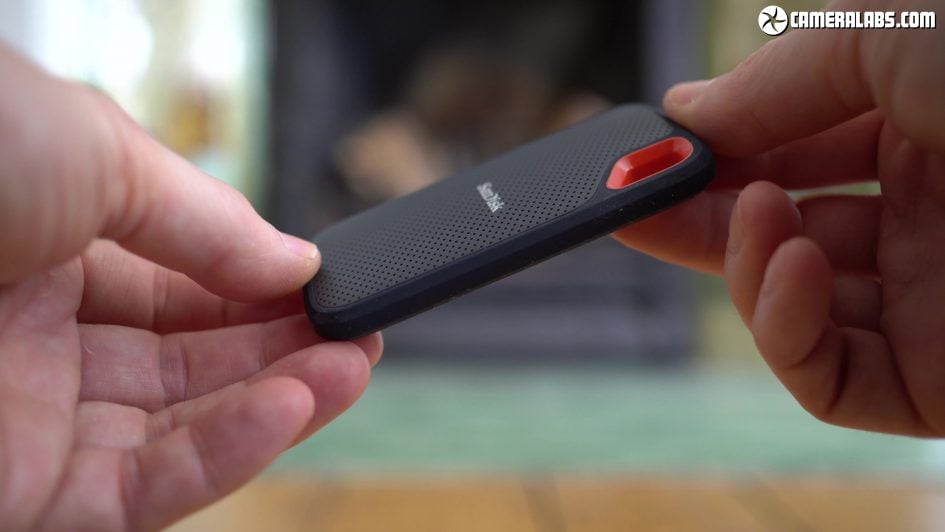
Above: I’ll start with the physical side: the SanDisk Extreme Portable SSD really is very very small, measuring just 50mm wide, 96mm tall and just under 9mm thick. That’s narrower than a credit card and small enough to squeeze into any pocket, and weighing just under 40g, you won’t notice it either.
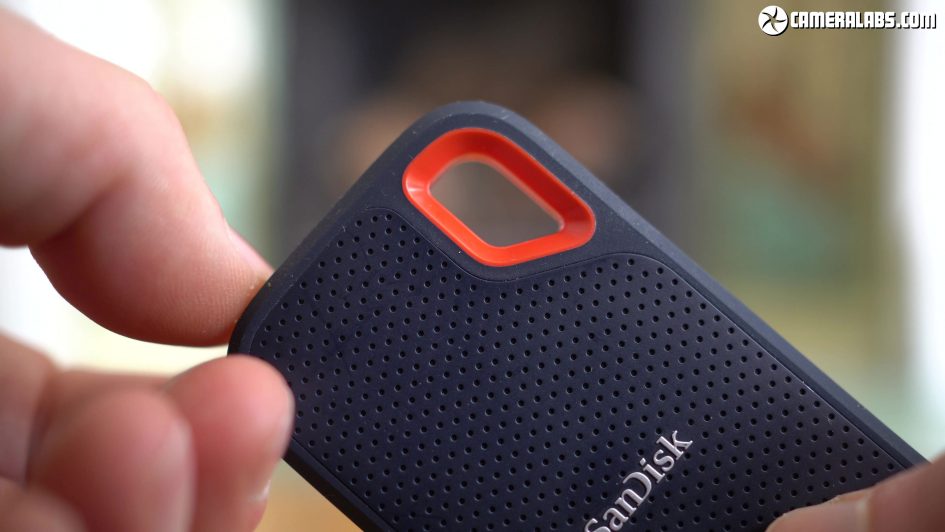
Above: Much of what differentiates one portable SSD from another is the case and finish, and SanDisk has sensibly chosen a rubberised shell with rounded corners that feels comfortable in your hands or again in a pocket. There’s also a handy cut-out allowing you to attach it to a keyring or hang-off a caribiner or D-ring. Most usefully of all though is the IP-55 rating for water-resistance. Before you get too excited, you can’t submerge the drive in water and expect it to survive, but it should shrug-off mild splashes, rain or moisture, so long as you’re careful to not expose the port. It also offers reasonable protection against shock and vibration and again while it’s not invincible, it will better-protect your data from knocks and small drops than a mechanical hard disk.
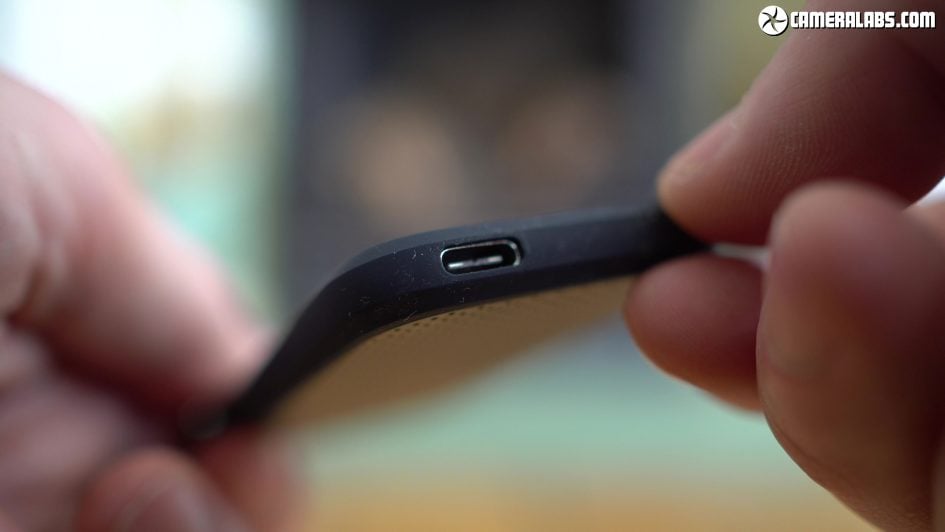
Above: Like all modern portable drives, there’s just one USB port used for data transfer and to power the device. SanDisk has again sensibly opted for a USB C port and supplies a short USB C to USB C cable in the box – short to maintain the fastest speeds. For backwards-compatibility with older-style ports, SanDisk also supplies a USB-C to USB-A adapter in the box, with arrow markings to ensure it’s connected the right way round. In terms of speed, the port supports USB 3.1 Gen 2 which provides more than enough bandwidth for the drive to operate at its top speeds, although of course your host may be the limiting factor, especially if it’s using older USB ports.
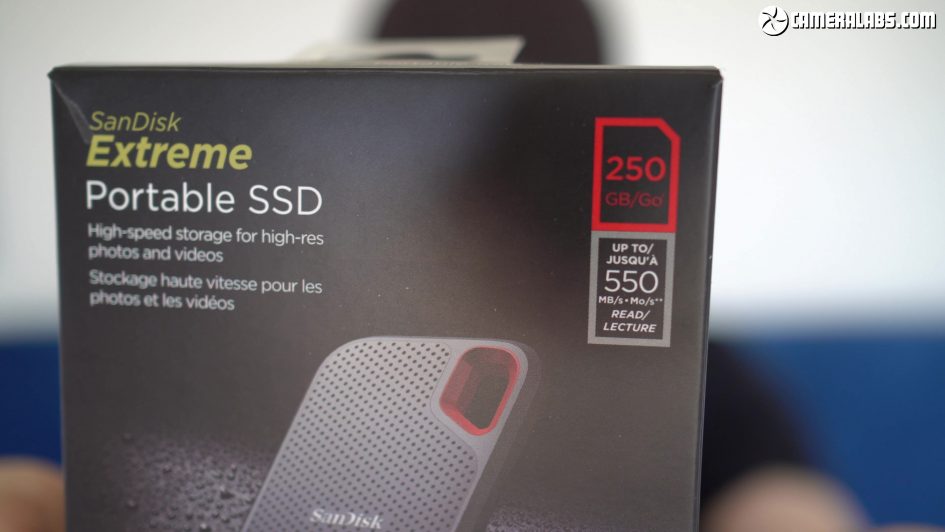
Above: SanDisk proudly quotes speeds up to 550 Mbyte/s on the box, which I came close to in my tests, at least under ideal conditions. For the best performance you will need to connect it to a port that supports USB 3.1 Gen 2, such as the USB C ports on a modern Mac.
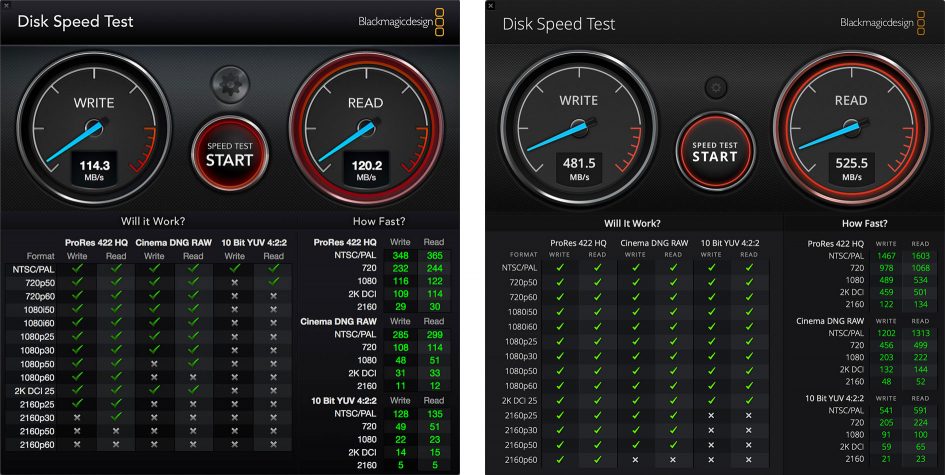
Above: When connected to my 2018 13in MacBook Pro, the BlackMagic Disk Speed Test utility measured over 480Mbyte/s for writes and over 525Mbyte/s for reads which is very good, and roughly four times faster than the speeds I measured from the WD My Passport 4TB drive, confirming the performance benefit. The SSD result is on the right and the WD result on the left.
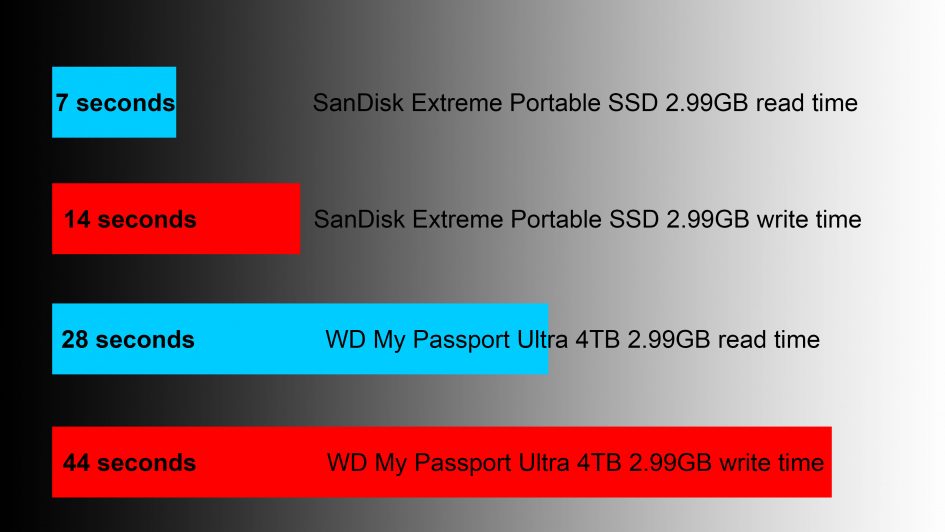
Above: The speed was also confirmed in real-life tests, where I timed the transfer of a 2.99GB folder of 177 JPEG and RAW images. Using the WD My Passport 4TB, it took 44 seconds to write the files from my Mac, then 28 seconds to read them back again after a restart to clear any caching. Compare that to the 14 seconds it took to write the same folder onto the SanDisk Extreme SSD and the mere seven seconds to read them back again. Around four times quicker when connected to a USB 3.1 Gen 2 port.

Above: I then tried the drive on an older PC running Windows 10, using Crystal Disk Mark to measure the speed. When connected to a USB 3 Gen 1 port, I measured read and write speeds of around 270Mbyte/s, roughly double that from the WD My Passport 4TB on the same port. Clearly the port on my older PC was proving a bottleneck for the new drive, but be careful because many PCs also have a bunch of even older USB 2 ports where I measured the speeds falling to around 40Mbyte/s. The moral of course being to ensure you connect it to your fastest ports for the best performance. If you have an old computer you may still prefer the SSD for its size and robustness though even if you won’t benefit from the speed.
As a photographer, I loved using the Extreme Portable SSD as a quick, compact and robust backup drive. At the end of a day’s shooting, I’d copy the card onto my laptop, then duplicate it onto the SSD. I’d then keep the SSD in a separate location to my computer, such as in a hotel safe when I was out with the laptop. The speed of the drive means you’ll never neglect performing backups, the size means you’ll always have it with you when you need it, and the robustness means you don’t need to treat it with kid gloves. I can literally throw it into a bag or slip it in a pocket and not worry.
As a video editor, I often find myself with giant folders of footage quickly consuming the internal drive on my laptop. Previously I’d free-up space by copying projects I wasn’t currently working on to portable drives or network storage, but the slow speed meant a huge folder could take so long to copy, it felt more like archiving. But with the SSD I can rapidly transfer huge folders back and forth – a recent 91GB project folder was copied from the drive to my Mac in just under three minutes, again confirming a speed close to 550Mbyte/s. It’s so fast it’s more like expanding your internal storage than connecting an external drive. I can even work directly from the drive whether it’s storing regular assets, an output render or even an entire project. Now the low disk space warning no longer means I’m out of action.

Above: Wherever I worked, I also liked how the drive was small and light enough to happily dangle from the end of its cable, without demanding flat desk space to rest on. You can even pick up your laptop with it still dangling without troubling the drive or your ports. So convenient when you’re literally working off your lap in a cafe or on a plane or train and need to get up or move around.
Verdict
Backing up your data, whether it’s photos, videos, music or plain old documents, is critically important, and a crucial part of the process is transporting the backup to a different location – after all, fire, flood and theft will rarely take one drive but leave the backup next to it unharmed. This is why portable drives are so useful. They can store and transport a large quantity of data quickly and easily – just one USB cable will transfer the data and power the drive, and once complete, they’re small enough to slip into a jacket or even trouser pocket. Their portability also makes them great for providing more storage for laptop owners who have filled their internal drives, but aren’t ready for a system upgrade quite yet.
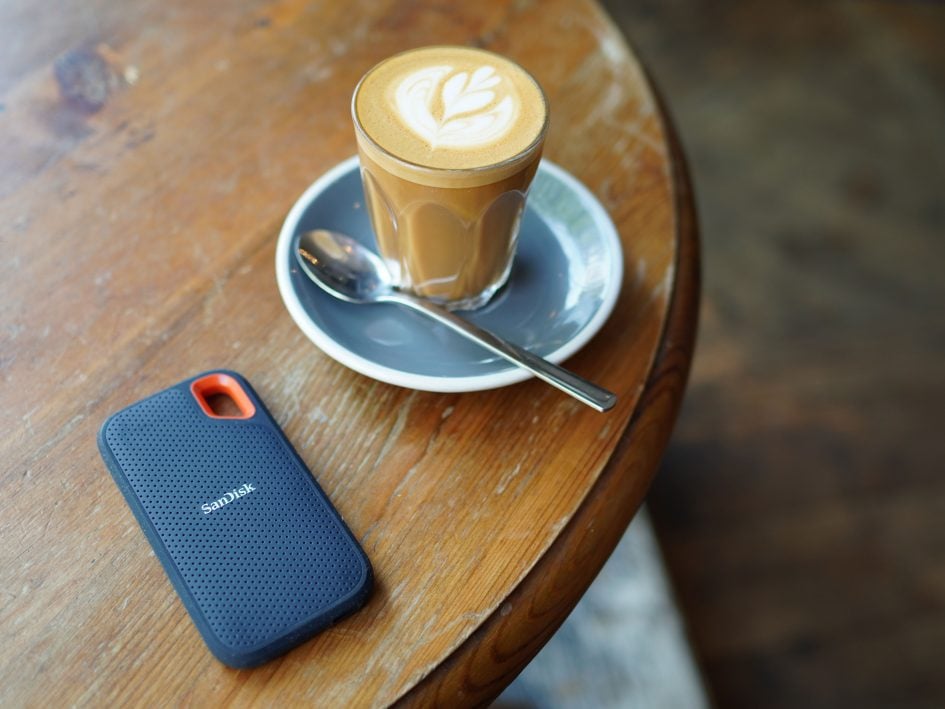
The SanDisk Extreme Portable SSD quickly found itself part of my workflow thanks to its speed, size and robustness, all of which meant I never had an excuse not to use it. In fact when connected to a fast USB C port, it feels more like expanding internal storage than plugging in an external drive; you can quite happily use it as a temporary boost in workspace for a big project rather than just considering it a backup device.
That said, I haven’t retired my old slower portable hard drives just yet. My 4TB Passport drives remain in service at home, backing-up larger amounts of data before relocating to different locations, but I no longer travel with them. The more compact, tougher and faster Extreme Portable SSD has become my go-to backup when I’m out and about, not to mention a convenient way to boost the storage on my laptop when working on big video projects. Highly recommended!
Check prices on the SanDisk Extreme Portable SSD at Amazon, B&H or Adorama, or at Amazon.co.uk Alternatively get yourself a copy of my In Camera book or treat me to a coffee! Thanks!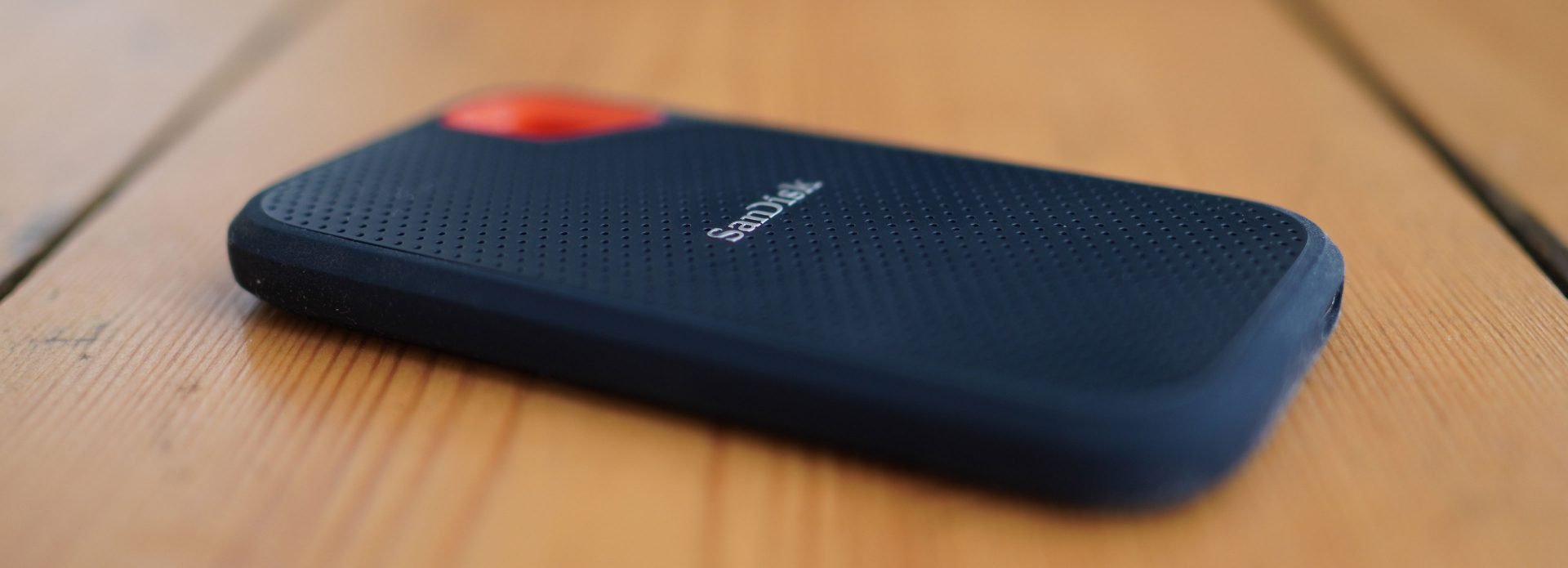
 The SanDisk Extreme Portable SSD is a rugged, pocket-sized drive that connects to new and old USB ports and exploits the size, speed and robustness of solid state storage. It works with Macs and PCs and is available in four models from 250GB to 2TB. It’s surprisingly compact, easily slipping into any pocket and the absence of moving parts makes it more robust and tolerant than traditional mechanical drives. The IP-55 rating allows it to shrug-off mild splashes, while the lightness means it can dangle from its short cable without damaging your ports - ideal for laptop workers who have to get up or move around. But it’s the speed that really impresses - when connected to a port that supports USB 3.1 Gen 2, like the USB-C ports on a modern Mac, it’ll achieve the quoted rates of up to 550Mbyte/s. This not only allows you to quickly backup data, but also easily free-up space to complete projects on a packed internal drive. Indeed it’s sufficiently fast for you to use it as active project storage when video editing, say to store common assets or a final render. I strongly believe everyone needs at least one portable drive, and if you value speed, size and robustness, the SanDisk Extreme Portable SSD is a perfect choice.
The SanDisk Extreme Portable SSD is a rugged, pocket-sized drive that connects to new and old USB ports and exploits the size, speed and robustness of solid state storage. It works with Macs and PCs and is available in four models from 250GB to 2TB. It’s surprisingly compact, easily slipping into any pocket and the absence of moving parts makes it more robust and tolerant than traditional mechanical drives. The IP-55 rating allows it to shrug-off mild splashes, while the lightness means it can dangle from its short cable without damaging your ports - ideal for laptop workers who have to get up or move around. But it’s the speed that really impresses - when connected to a port that supports USB 3.1 Gen 2, like the USB-C ports on a modern Mac, it’ll achieve the quoted rates of up to 550Mbyte/s. This not only allows you to quickly backup data, but also easily free-up space to complete projects on a packed internal drive. Indeed it’s sufficiently fast for you to use it as active project storage when video editing, say to store common assets or a final render. I strongly believe everyone needs at least one portable drive, and if you value speed, size and robustness, the SanDisk Extreme Portable SSD is a perfect choice.



